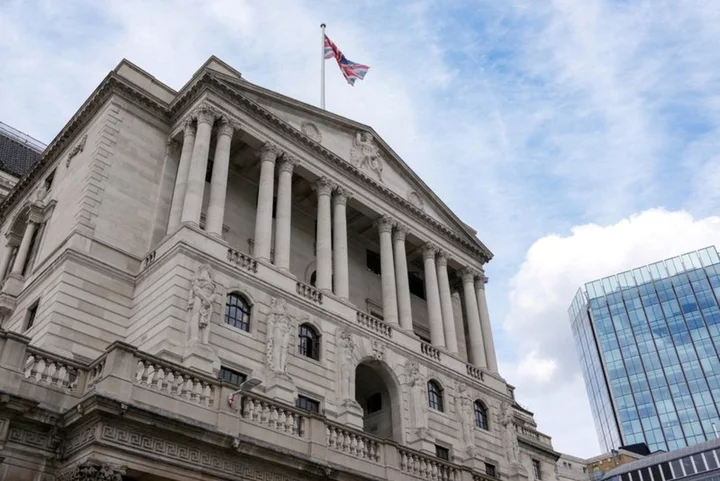By Mike Dolan
LONDON If the Bank of England is indeed done hiking rates, it calls time on a dire couple of years for British government bonds - even as the central bank offloads more of its gilt stockpile.
Bruised and battered bond bulls now look to Britain for hope of some redemption in yet another year of losses across sovereign debt markets - not least as they absorb a fresh hit to U.S. Treasuries after the Federal Reserve this week signalled one more hike was in store and upped its growth forecasts.
But preempted by news of a surprise drop in UK inflation last month and the likelihood of further disinflation over the coming months, a split BoE policymaking council on Thursday halted - at least temporarily - its relentless two-year crunch.
It's been enough to prompt many banks to say peak UK rates are now finally in at 5.25% after more than 500 basis points of increases - a cycle that BlackRock points out is three times the size of any squeeze since the BoE took sole charge of rate setting in 1997.
To be sure, Britain has been an inflation outlier to date in the post-pandemic price surge. It has struggled more than most with the Russia-seeded energy shock and gilts suffered severe credibility damage in the aborted budget giveaway one year ago.
But with its underlying economy weaker and more prone to the imminent mortgage rate resets than its peers, UK bonds may at last be priced better than other G7 debt for the road ahead.
"From a total return perspective within the sovereign space, 10-year gilts are probably the most attractive bond market," said Oliver Eichmann, portfolio manager at giant German asset manager DWS, even as he cautioned that a second wave of global inflation was still obviously a risk for all bond markets.
Many funds have already been jockeying for position.
From a 15-year peak of 4.75% just a month ago, 10-year nominal gilt yields have dropped almost 50 basis points already, falling below U.S. and Australian equivalents for the first time since March. Two-year gilt yields have plunged almost a full percentage point since July and, at 4.85%, are now below U.S. and Canadian counterparts.
And yet despite the recent rebound, catchall exchange traded funds in gilts are still down more than twice U.S. and European peers for the year to date, and investors still see value in UK bonds.
"Gilts look at attractive levels with the BoE on hold," said Franklin Templeton's David Zahn, adding FT was now positioned "long duration" in its gilt fund and had added currency-hedged gilts to its European fixed income accounts.
While BlackRock strategist Vivek Paul described the UK economic outlook as "bleak", he added: "The positive news is that UK asset pricing does reflect much of this story, which makes UK gilts and equity attractive relative to U.S. peers."
Candriam fund manager Jamie Niven also fancies UK rates over global peers, with "the market underestimating the current level of restrictiveness."
DO NOTHIN'
And therein lies the rub for many investors.
What UBS economist Paul Donovan dubs the "doing nothing" policy - otherwise known as "higher for longer" - automatically lifts the real cost of credit in economies going forward as income growth subsides.
UK wage growth remains brisk - but the situation is compounded in Britain as refinancing in the now dominant UK fixed-rate mortgage market comes quicker than in the United States or euro zone as most are still just for two to five years in length.
"Without hiking rates again, the impact of rate hikes will continue to ramp up," said ING's James Smith, adding that the length of time rates stay high is much more important than how high they go in the short term.
Smith pointed out that the average rate on existing UK mortgage lending has gone from roughly 2% to 3% already but as more people refinance that heads to 4% by next spring and probably 4.5% by the end of next year.
"Ultimately the UK economy can't sustain rates above 5% indefinitely and we think something closer to 3% is a more likely medium-term level," he said.
And hence while the UK may not have been the first major central bank to hit peak rates - the European Central Bank likely beat it to that last week even if the U.S. Federal Reserve still feints at one more hike - the BoE may well be the first to cut next year despite it's "higher for longer" spiel.
What could possibly go wrong for gilts?
A second-wave inflation spike - which is worrying given the recent backup in energy prices - is clearly a risk for all bond markets and policymakers. And a renewed plunge in sterling could compound that effect on dollar-demominated energy and commodity import prices.
A year on from the 2022 budget farce, fiscal policy is always a concern. But Finance Minister Jeremy Hunt on Wednesday stuck to his tighter budget stance by insisting tax cuts this year were "virtually impossible".
The BoE's decision to cut its stockpile of bonds by 100 billion pounds ($122.91 billion) over the next 12 months - via both sales and allowing bonds to mature - was higher than the 80 billion pounds reduction over the past year and may rankle.
Like the Fed and the ECB, the BoE will be keen for bond markets not to loosen prematurely before inflation falls further.
But Thursday's balance sheet had been well flagged by the BoE in advance and it claimed this summer that extensive market liaison suggests the additional amount can be absorbed without disruption.
For some, this nudge on long-term liquidity merely reinforces the chance that the BoE is now done on policy rates.
And so, long the laggard, gilts may well be back in vogue.
The opinions expressed here are those of the author, a columnist for Reuters
($1 = 0.8136 pounds)
(Editing by Jamie Freed)

